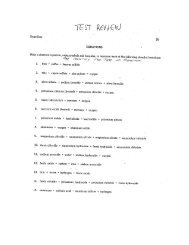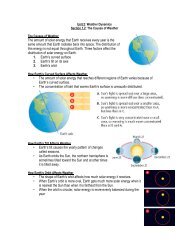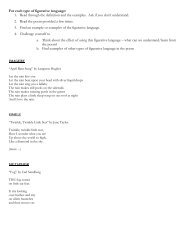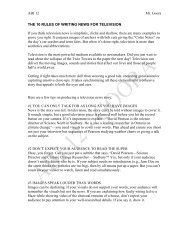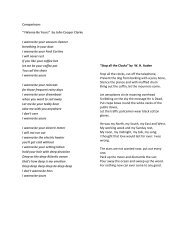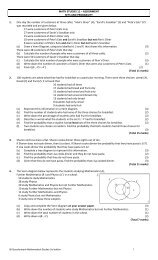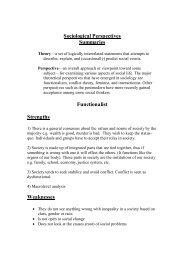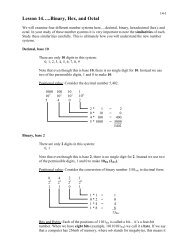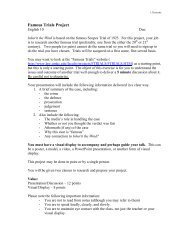8.6 Density and Buoyancy in Action - HRSBSTAFF Home Page
8.6 Density and Buoyancy in Action - HRSBSTAFF Home Page
8.6 Density and Buoyancy in Action - HRSBSTAFF Home Page
Create successful ePaper yourself
Turn your PDF publications into a flip-book with our unique Google optimized e-Paper software.
<strong>Density</strong> <strong>and</strong> <strong>Buoyancy</strong><br />
<strong>in</strong> <strong>Action</strong><br />
<strong>Density</strong> <strong>and</strong> buoyancy are closely related characteristics of fl uids that<br />
help us underst<strong>and</strong> how plants <strong>and</strong> animals—<strong>in</strong>clud<strong>in</strong>g humans—<br />
make use of fl uids.<br />
Oil <strong>and</strong> Water<br />
Oil is usually less dense than water, so it fl oats on the surface of water.<br />
Th is property of oil is both harmful <strong>and</strong> helpful dur<strong>in</strong>g oil spills.<br />
Th e oil is harmful to aquatic <strong>and</strong> shore plants <strong>and</strong> animals. It may<br />
contam<strong>in</strong>ate their food, make it diffi cult for them to breathe, <strong>and</strong><br />
destroy the <strong>in</strong>sulat<strong>in</strong>g eff ect of fur or feathers.<br />
However, the fact that oil is less dense than water is helpful <strong>in</strong><br />
clean<strong>in</strong>g up oil spills. Float<strong>in</strong>g booms are used to encircle oil spills on<br />
the surface of the water (Figure 1). Th en, collection devices scoop,<br />
soak, or suck up much of the captured oil.<br />
Airships, Balloons, <strong>and</strong> Blimps<br />
On May 6, 1937, the German airship H<strong>in</strong>denburg completed its<br />
twenty-fi rst cross<strong>in</strong>g of the Atlantic Ocean. While dock<strong>in</strong>g <strong>in</strong> New<br />
Jersey, U.S.A., it caught fi re <strong>and</strong> burned with<strong>in</strong> seconds (Figure 2).<br />
Th e 245-metre-long craft was fi lled with hydrogen gas—less expensive<br />
<strong>and</strong> less dense than helium, but extremely explosive. Th irty-six people<br />
died <strong>in</strong> the disaster—thirty-three of them when they jumped from the<br />
burn<strong>in</strong>g airship.<br />
Today, “lighter-than-air” craft are used ma<strong>in</strong>ly for advertis<strong>in</strong>g <strong>and</strong><br />
recreation. Some, like the Goodyear blimps, are helium-fi lled airships<br />
that propel themselves through the air. Most, however, are hot air<br />
balloons fi lled with air heated by burners <strong>and</strong> attached to a basket<br />
or other type of passenger compartment. Th e balloon is open at the<br />
bottom. Th e heated air rises <strong>in</strong>to the balloon, forc<strong>in</strong>g the cooler,<br />
heavier air out the open<strong>in</strong>g. Th e hot air <strong>in</strong>side the balloon is much<br />
less dense than the colder outside air <strong>and</strong> makes the balloon buoyant<br />
(Figure 3).<br />
Figure 2 The H<strong>in</strong>denburg disaster<br />
reduced the number of large air ships<br />
used for commercial transportation.<br />
NEL<br />
Figure 3 Designers must consider density <strong>and</strong><br />
buoyancy when creat<strong>in</strong>g specialized hot air<br />
balloons.<br />
<strong>8.6</strong><br />
Figure 1 This fl oat<strong>in</strong>g boom has<br />
trapped most of the spilled oil.<br />
To learn more about the<br />
H<strong>in</strong>denburg <strong>and</strong> other<br />
“lighter-than-air” craft,<br />
Go to Nelson Science<br />
<strong>8.6</strong> <strong>Density</strong> <strong>and</strong> <strong>Buoyancy</strong> <strong>in</strong> <strong>Action</strong> 219
Figure 4 The rounded portions of<br />
the water hyac<strong>in</strong>th stem conta<strong>in</strong> air,<br />
mak<strong>in</strong>g this water plant less dense<br />
than the water it lives <strong>in</strong>.<br />
swim bladder: a controllable,<br />
balloon-like chamber that allows<br />
fi sh to alter their buoyancy<br />
valves<br />
ballast<br />
tank<br />
swim bladder<br />
Figure 5 The oxygen <strong>in</strong> a fi sh’s swim bladder comes from<br />
the dissolved oxygen <strong>in</strong> the water.<br />
ballast tanks: compartments <strong>in</strong> a<br />
ship or submar<strong>in</strong>e that take <strong>in</strong> water<br />
to keep the ship stable or help a<br />
submar<strong>in</strong>e dive below the surface<br />
compressed air tanks<br />
The Importance of <strong>Buoyancy</strong><br />
Water hyac<strong>in</strong>th (Figure 4) is a fl oat<strong>in</strong>g plant used <strong>in</strong> pond gardens.<br />
Water hyac<strong>in</strong>th’s buoyancy is due to numerous air chambers <strong>in</strong> its<br />
stem. Humans use this idea of fl otation chambers <strong>in</strong> a wide range of<br />
devices, such as life preservers, fl oat plane pontoons, <strong>and</strong> pool chairs.<br />
The <strong>Buoyancy</strong> of Fish <strong>and</strong> Submar<strong>in</strong>es<br />
Most bony fi sh ma<strong>in</strong>ta<strong>in</strong> their position <strong>in</strong> the water with the use of a<br />
swim bladder, a th<strong>in</strong>-walled sac <strong>in</strong> their bodies that conta<strong>in</strong>s ma<strong>in</strong>ly<br />
oxygen (Figure 5). Fish can alter the volume of water they displace<br />
<strong>and</strong> their overall density by adjust<strong>in</strong>g the amount of oxygen <strong>in</strong> the<br />
bladder. Th is changes their buoyancy <strong>in</strong> the water. Th e more oxygen <strong>in</strong><br />
the bladder, the higher they fl oat; the less oxygen, the more they s<strong>in</strong>k.<br />
Th is helps fi sh save energy while ma<strong>in</strong>ta<strong>in</strong><strong>in</strong>g their depth <strong>in</strong> the water.<br />
Th e oxygen comes from the dissolved oxygen <strong>in</strong> the<br />
water <strong>and</strong> enters <strong>and</strong> leaves the bladder through the<br />
fi sh’s blood.<br />
Submar<strong>in</strong>es work <strong>in</strong> a similar manner to the<br />
swim bladder. Submar<strong>in</strong>es conta<strong>in</strong> ballast tanks <strong>in</strong><br />
place of the bladders. Ballast tanks are specialized<br />
chambers that can be fi lled with air or water to<br />
control the depth of the submar<strong>in</strong>e. To make the<br />
submar<strong>in</strong>e descend, valves are opened to take on<br />
more water <strong>in</strong> the ballast tanks (Figure 6).<br />
To surface, air from compressed air tanks is forced<br />
<strong>in</strong>to the ballast tanks, displac<strong>in</strong>g the water <strong>and</strong> reduc<strong>in</strong>g the ship’s<br />
mass-to-volume ratio. Th is reduction <strong>in</strong> density causes the buoyant<br />
force of the surround<strong>in</strong>g water to carry the submar<strong>in</strong>e to the surface.<br />
surfaced<br />
air valves open<br />
air expelled from ballast tank<br />
s<strong>in</strong>k<strong>in</strong>g<br />
water valves open<br />
water enters ballast tank<br />
compressed air valves open<br />
air forced <strong>in</strong>to ballast tank<br />
water valves open<br />
water expelled from ballast tank<br />
Figure 6 A submar<strong>in</strong>e’s ballast tank works like a fi sh’s swim bladder.<br />
220 Chapter 8 • <strong>Density</strong> <strong>and</strong> <strong>Buoyancy</strong> NEL<br />
ris<strong>in</strong>g
By controll<strong>in</strong>g the amount of air <strong>in</strong> these specialized chambers,<br />
submar<strong>in</strong>es <strong>and</strong> fi sh can change their density, caus<strong>in</strong>g positive,<br />
negative, or neutral buoyancy. When positive buoyancy occurs, the<br />
object beg<strong>in</strong>s to fl oat upward; negative buoyancy causes the object to<br />
s<strong>in</strong>k. Neutral buoyancy occurs when the submar<strong>in</strong>e or fi sh rema<strong>in</strong>s <strong>in</strong><br />
one place, neither ris<strong>in</strong>g nor s<strong>in</strong>k<strong>in</strong>g.<br />
NEL<br />
TRY THIS: Build<strong>in</strong>g a Cartesian Diver<br />
SKILLS MENU: perform<strong>in</strong>g, observ<strong>in</strong>g, analyz<strong>in</strong>g, communicat<strong>in</strong>g<br />
The Cartesian diver, along with other toys based on it, has<br />
enterta<strong>in</strong>ed science students <strong>and</strong> children around the world<br />
for hundreds of years. In this activity, you will build your own<br />
Cartesian diver.<br />
Equipment <strong>and</strong> Materials: scissors; 2 L plastic pop bottle<br />
(labels removed) with lid; plastic dr<strong>in</strong>k<strong>in</strong>g straw; metal paper<br />
clips; modell<strong>in</strong>g clay (optional); conta<strong>in</strong>er of water<br />
1. Cut a plastic dr<strong>in</strong>k<strong>in</strong>g straw <strong>in</strong> half. Bend the straw <strong>in</strong> half.<br />
Secure the bent straw by us<strong>in</strong>g a paper clip.<br />
2. Loop four or fi ve additional paper clips over the clip keep<strong>in</strong>g<br />
the straw bent (alternatively, add a small lump of modell<strong>in</strong>g<br />
clay to the paper clip). This is your diver.<br />
3. Place the diver <strong>in</strong>to the conta<strong>in</strong>er of water. The diver should<br />
just fl oat on the surface of the water (Figure 7). If it does<br />
not, add or remove weight (paper clips or modell<strong>in</strong>g clay)<br />
from the diver until it fl oats.<br />
4. Fill the 2 L bottle almost to the top with water. Place the<br />
diver <strong>in</strong> the bottle <strong>and</strong> put the lid on tightly.<br />
5. When you squeeze the sides of the bottle, you force<br />
more water <strong>in</strong>to the straw. Observe what happens to the<br />
diver. How can you get the diver to demonstrate positive,<br />
negative, <strong>and</strong> neutral buoyancy?<br />
Cartesian divers, submar<strong>in</strong>es, <strong>and</strong> fi sh with swim bladders all<br />
demonstrate a common pr<strong>in</strong>ciple: objects that displace a greater<br />
volume of fl uid are more buoyant than those that displace less fl uid.<br />
Unit Task <strong>Buoyancy</strong> is often considered when design<strong>in</strong>g air <strong>and</strong> water toys.<br />
How might you use buoyancy <strong>in</strong> design<strong>in</strong>g your toy?<br />
CHECK C<br />
YOUR LEARNING<br />
1. What is the most important idea you learned <strong>in</strong> this section?<br />
Expla<strong>in</strong> the reasons for your choice.<br />
2. Describe two <strong>in</strong>stances <strong>in</strong> which humans might have used<br />
examples from nature when design<strong>in</strong>g devices that use the<br />
properties of density <strong>and</strong> buoyancy.<br />
A. In your notebook, make a labelled draw<strong>in</strong>g of your Cartesian<br />
diver <strong>in</strong> a bottle.<br />
B. Record your observations as you squeeze <strong>and</strong> release the<br />
bottle.<br />
C. Expla<strong>in</strong> how a Cartesian diver can demonstrate positive,<br />
negative, <strong>and</strong> neutral buoyancy. Use sketches if you wish.<br />
Figure 7 Your diver should just fl oat on the surface<br />
of the water.<br />
SKILLS HANDBOOK<br />
4.C.1.<br />
3. Is the density of oil helpful or harmful when deal<strong>in</strong>g with oil<br />
spills? Expla<strong>in</strong> your answer.<br />
4. (a) Expla<strong>in</strong> how ballast tanks work. You may use a diagram<br />
<strong>in</strong> your explanation.<br />
(b) How is a fi sh swim bladder similar to a submar<strong>in</strong>e<br />
ballast tank?<br />
<strong>8.6</strong> <strong>Density</strong> <strong>and</strong> <strong>Buoyancy</strong> <strong>in</strong> <strong>Action</strong> 221



